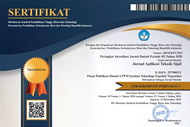Analisis Degradasi Performa Marka Jalan Thermoplastik Pada Jalan Tol
Abstract
Keywords
Full Text:
PDFReferences
Y. Oktopianto, S. Shofiah, F. A. Rokhman, and K. Pangestu, “Analisis Daerah Rawan Kecelakaan ( Black Site ) Dan Titik Rawan Kecelakaan ( Black Spot ) Provinsi Lampung,” Borneo Eng. J. Tek. Sipil, vol. 5, no. 1, pp. 40–51, 2021, doi: 10.35334/be.v5i1.1777.
Y. Oktopianto and D. W. Hidayat, “Reflectivity Analysis and Maintenance Program of Road Markings IR . WIYOTO WIYONO Toll Road,” J. Adv. Res. Dyn. Control Syst., vol. 12, no. 02, pp. 3118–3122, 2020, doi: 10.5373/JARDCS/V12I2/S20201431.
F. E. Loetterle, R. A. Beck, and J. Carlson, “Public perception of pavement-marking brightness,” Transp. Res. Rec., 2000, doi: 10.3141/1715-08.
D. Chimba, E. Kidando, and M. Onyango, “Evaluating the service life of thermoplastic pavement markings: Stochastic approach,” J. Transp. Eng. Part B Pavements, 2018, doi: 10.1061/JPEODX.0000055.
P. Lertworawanich and A. Karoonsoontawong, “Service life analysis and maintenance program of pavement markings in Thailand,” Transp. Res. Rec., 2012, doi: 10.3141/2272-14.
L. Ozelim and R. E. Turochy, “Modeling retroreflectivity performance of thermoplastic pavement markings in Alabama,” J. Transp. Eng., 2014, doi: 10.1061/(ASCE)TE.1943-5436.0000661.
A. M. Pike, L. D. Ballard, and P. J. Carlson, “Evaluation of retroreflectivity measurement techniques for profiled and rumble stripe pavement markings,” Transp. Res. Rec., 2011, doi: 10.3141/2258-10.
W. E. Sitzabee, J. E. Hummer, and W. Rasdorf, “Pavement Marking Degradation Modeling and Analysis,” J. Infrastruct. Syst., 2009, doi: 10.1061/(asce)1076-0342(2009)15:3(190).
N. Aznirahani, M. Yunin, N. Sheda, M. Zulkiffli, A. Shabadin, and S. Z. Ishak, “Effect of Enhanced Road Marking in Road Safety-Speed and Lateral Position,” J. Built Environ., 2018.
M. Hadi and P. Sinha, “Effect of pavement marking retroreflectivity on the performance of vision-based lane departure warning systems,” J. Intell. Transp. Syst. Technol. Planning, Oper., 2011, doi: 10.1080/15472450.2011.544587.
M. H. Harun, N. S. Mohamad Noh, and W. R. Wan Hanafi, “Brighter and better all-weather road markings in malaysia,” in Bituminous Mixtures and Pavements VI - Proceedings of the 6th International Conference on Bituminous Mixtures and Pavements, ICONFBMP 2015, 2015, doi: 10.1201/b18538-104.
G. L. M. Leung, A. W. G. Wong, S. H. F. Wong, and S. You, “Study on wet visibility of road markings in Hong Kong,” in Proceedings of the 21st International Conference of Hong Kong Society for Transportation Studies, HKSTS 2016 - Smart Transportation, 2018.
M. Mohamed, A. Abdel-Rahim, E. Kassem, K. Chang, and A. G. McDonald, “Laboratory-Based Evaluation of Pavement Marking Characteristics,” J. Transp. Eng. Part B Pavements, 2020, doi: 10.1061/jpeodx.0000168.
D. B. Clarke and Y. Xuedong, “Retroreflectivity performance of 90-mil thermoplastic longitudinal pavement markings during the early application period,” Adv. Transp. Stud., 2010.
O. Smadi, R. R. Souleyrette, D. J. Ormand, and N. Hawkins, “Pavement marking retroreflectivity analysis of safety effectiveness,” Transp. Res. Rec., 2008, doi: 10.3141/2056-03.
C. Debaillon, P. J. Carlson, H. G. Hawkins, Y. He, T. Schnell, and F. Aktan, “Review and development of recommended minimum pavement marking retroreflectivity levels,” Transp. Res. Rec., 2008, doi: 10.3141/2055-09.
DOI: http://dx.doi.org/10.12962%2Fj2579-891X.v19i4.9222
Refbacks
- There are currently no refbacks.

Jurnal Aplikasi Teknik Sipil by Pusat Publikasi Ilmiah LPPM Institut Teknologi Sepuluh Nopember is licensed under a Creative Commons Attribution-ShareAlike 4.0 International License
Based on work at https://iptek.its.ac.id/index.php/jats




